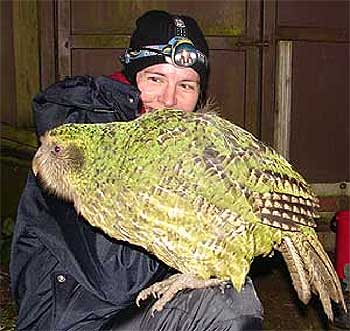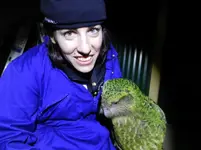Dear (someone who knows much about kakapos),
Could you please answer these questions. It would really help me.
- What are the exact living conditions of the kakapo?
kakapo were once widespread across both the north and south islands of new zealand. they are quite capable of living in a wide range of terrain - from coastal scrub to sub-alpine grasslands. they seem to prefer beech forests. they are general herbavores, meaning that they can eat a large range of plants. looking at fossilized coprolites (aka, poop), botanists have found that kakapo living on the main islands once consumed upwards of 80 different species. kakapo mostly eat the leaves, stems, and shoots of plants, but also eat berries, flowers, seeds, nuts, nectar, pollen, roots, tubers, etc, depending on availability. kakapo usually eat by grasping the stem of a plant with their large feet and then stripping it of desired tissue. kakapo need quite a large area to roam in order to get enough browsing material. As the leafy portion of plants are fairly low in nutritive value, they need to have access to a lot of high quality plants in order to thrive - several hectares per bird is about average, but this really depends on the social status of the bird and the quality of the habitat. kakapo rely on the masting (large production of fruit) of certain podocarps and tussock grasses in order to breed. masting only occurs once every 4 to 7 years on average, and thus the birds rarely breed more than one year in a row. when they occupy their preferred habitat - beech forests - kakapo are reliant on high levels of structural diversity in order to be able to use their strong climbing ability to move from the forest floor to the canopy. Contrary to popular myth, kakapo do not jump out of large trees - they actually climb down, usually the way they came!
- In what way is the kakapo protected?
the kakapo is a critically endangered parrot, and while this isn't great, it is actually an improvement as the parrot was listed as extinct in the wild as recently as 1996. kakapo are part of iucn's red list. main threats to the birds are invasive mammals that can kill chicks or adults or eat eags, low fertility rate that has been caused by in-breeding depression, disease, dominance fights between males, and low reproductive and recruitment rates. the kakapo is intensively managed by a special group known as the kakapo recovery team, which is part of the larger Department of Conservation. All known birds are banded and radiotagged. Each bird is monitored throughout the year, including being weighed daily by digital scales - in order to get the weights in a non-invasive manner KRT has placed customized food hoppers in their territories that only open for one particular bird. the scales are located below the food hoppers and are triggered when the birds come to feed. the hoppers also allow KRT to incorporate customized feeding routines into the close-order management of the population. Mandatory health check-ups are conducted at least annually. During the breeding season, the KRT goes into overdrive and carefully monitors the breeding status of each of the birds. Any breeding activity is closely followed - and any resulting nests are equipped with infrared cameras and two nest-minders who camp nearby to advert any potential disasters. All known birds have dna profiles that are used to manipulate the rather small gene pool in the best way possible. kakapo are actually the wild bird population in the world to have completed artificial insemination trails successfully!
Today, kakapo are only found on four, remote off-shore islands: Anchor, Little Barrier, Codfish, and Maud. The only way on or off these islands is by plane or helicopter and access is strictly controlled. Landing on one of the islands without proper permits would result in several large fines!
- What does the kakapo drink and eat the most?
Kakapo drinks water the most. Food is a bit of a different story and really depends on the habitat it occupies. Some favorites seem to be: astelia, gahnia, tutu, flax, various sedges, grasses, rushes and ferns, rata, totara, leatherwood, etc.
- What kind of a tree has to blossom to trigger the kakapo to breed?
As far as we know, kakapo can be triggered to breed by rimu, a few podocarp trees, and tussock grasses. It is possible that the birds may have been reliant on other trees at one time, but no other plants have been confirmed at this point.
- Is the percentage important of trees necessary, in the kakapo’s territory, to trigger the kakapo to breed, or is the quantity of blossom important?
it appears that it is the percentage of fruit on the plant that triggers breeding. In order for rimu to trigger breeding, about 10% of the branch tips need to be fruiting. Of course, a kakapo must have access to habitat that includes rimu in order for breeding to triggered. as these plants are a limited resource, not all birds will have access to them (due to the lack of presence in some less dominant birds' homeranges) and thus may not be triggered to breed during a masting year.
- What exactly and how much should the kakapo eat to become fertile?
This is still uncertain. It was once thought that by replicating the fat and amino acid content in the kakapo's diet, breeding could be triggered; however, this turned out to be wrong. in fact, when females were given too much extra food, they became overweight. This in turn cause the appearance of a sex bias towards males; which was far from ideal since there were already more male than female kakapo! Females that became obese don't breed at all.... So, keeping a female kakapo in breeding condition is tricky indeed - her diet has to be just right in order to keep a 50:50 sex ratio. The KRT keeps a close eye on the weights of all breeding feeding females and has customized each birds diet in order to optimize their breeding condition.
- Does the nutrition have influence on the “mum” kakapo to give birth to a boy or a girl?
YES! see above.

- Are there no ways to stimulate kakapo’s to breed, like sounds or something else?
It doesn't appear to be the case. Scientists still are not 100% what exactly triggers breeding since the birds seems to be able to tell when a masting year is coming up - they start fattening up before any noticeable ripening of fruit!
- Where does the kakapo make its nest?
kakapo nest in natural occurring cavities. the most commonly used nesting sites have been known to include standing and fallen tree snags, holes in the ground (i.e., up-ended root clumps), caves, and under dense vegetative cover. many of the nests are often modified by the KRT to improve nesting success[FONT="].
[/FONT]
- What is your opinion about the kakapo?
They are, without a doubt, one of the COOLEST bird on planet!
Also, the plural of kakapo is kakapo.

Yours sincerely Jari













